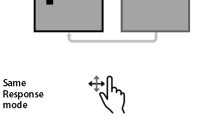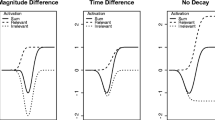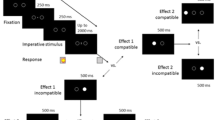Abstract
It is widely held that the spatial compatibility effect emerges because the irrelevant spatial dimension of the target stimulus activates a response simultaneous to the activation of a response to the relevant stimulus dimension. The non-target response facilitates response planning on compatible trials, but interferes with response planning on incompatible trials. In support of this hypothesis, the trajectories of aiming movements executed on incompatible trials deviate in the direction of the stimulus location. These deviations are thought to occur because the characteristics of the simultaneously active target and non-target responses merge. Previously, target stimuli were presented at the target locations leaving open the possibility that the response activation and subsequent deviations were dependent on the stimulus-driven attentional capture associated with the dynamic change of stimulus onset. The present research was conducted to determine if attention capturing events at the target locations were necessary for the movement deviations to emerge by investigating if trajectory deviations are also observed when the spatial dimension is presented centrally. Participants in the Central condition aimed to left and right target locations based on the color of a ring worn on a finger that pointed toward the response locations. Similar to results from a Peripheral condition, trajectory deviations were observed in the Central condition. Although it is unclear if the deviations in the Central condition occurred because of attentional shifts driven by the cue or response preplanning, these results demonstrate that dynamic changes at target locations are sufficient, but not necessary, to generate trajectory deviations.


Similar content being viewed by others
References
Atsunori, A., & Katsumi, W. (2009). What is special about the index finger? The index finger advantage in manipulating reflexive attentional shift. Japanese Psychological Research, 51, 258–265.
Böckler, A., van der Wel, R. P., & Welsh, T. N. (2014). Catching eyes: effects of social and non-social cues on attention capture. Psychological Science, 25, 720–727.
Buetti, S., & Kerzel, D. (2009). Conflicts during response selection affect response programming: reactions toward the source of stimulation. Journal of Experimental Psychology: Human Perception and Performance, 35, 816–834.
Cisek, P., & Kalaska, J. F. (2002). Simultaneous encoding of multiple potential reach directions in dorsal premotor cortex. Journal of Neurophysiology, 87, 1149–1154.
Cisek, P., & Kalaska, J. F. (2005). Neural correlates of reaching decisions in dorsal premotor cortex: specification of multiple direction choices and final selection of action. Neuron, 45, 801–814.
De Jong, R., Liang, C. C., & Lauber, E. (1994). Conditional and unconditional automaticity: a dual-process model of effects of spatial stimulus-response correspondence. Journal of Experimental Psychology: Human Perception and Performance, 20, 731–750.
Folk, C. L., Remington, R. W., & Johnston, J. C. (1992). Involuntary covert orienting is contingent on attentional control settings. Journal Experimental Psychology: Human Perception & Performance, 18, 1030–1044.
Friesen, C. K., & Kingstone, A. (1998). The eyes have it! Reflexive orienting is triggered by nonpredictive gaze. Psychonomic Bulletin & Review, 5, 490–495.
Frischen, A., Bayliss, A. P., & Tipper, S. P. (2007). Gaze cueing of attention: visual attention, social cognition, and individual differences. Psychological Bulletin, 133, 694–724.
Georgopoulos, A. P. (1990). Neurophysiology of reaching. In M. Jeannerod (Ed.), Attention and performance XIII (pp. 227–263). Hillsdale, NJ: Lawrence Erlbaum.
Hommel, B., Pratt, J., Colzato, L., & Godijn, R. (2001). Symbolic control of visual attention. Psychological Science, 12, 360–365.
Jonides, J. (1981). Voluntary versus automatic control over the mind’s eye’s movement. In J. Long & A. Baddley (Eds.), Attention and performance IX (pp. 187–203). Hillsdale, NJ: Lawerence Erlbaum Assoc.
Khun, G., & Kingstone, A. (2009). Look away! Eyes and arrows engage oculomotor responses automatically. Attention, Perception, & Psychophysics, 71, 314–327.
Kornblum, S., Hasbroucq, T., & Osman, A. (1990). Dimensional overlap: cognitive basis for stimulus–response compatibility—a model and taxonomy. Psychological Review, 97, 253–270.
Langton, S. R. H., & Bruce, V. (1999). Reflexive visual orienting in response to the social attention of others. Visual Cognition, 6, 541–567.
Posner, M. I., & Cohen, Y. (1984). Components of visual orienting. In H. Bouma & D. Bowhuis (Eds.), Attention and performance X (pp. 531–556). Hillsdale, NJ: Erlbaum.
Rizzolatti, G., & Craighero, L. (2004). The mirror-neuron system. Annual Reviews in Neuroscience, 27, 169–192.
Rizzolatti, G., Riggio, L., & Sheliga, B.M. (1994). Space and selective attention. In C. Umilta & M Moscovitch (Eds.), Attention and performance XV (pp. 231–265). Cambridge, MA: MIT.
Sato, W., Kochiyama, T., Uono, S., & Yoshikawa, S. (2010). Automatic attentional shifts by gaze, gestures, and symbols. Psychologia, 53, 27–35.
Scherbaum, S., Dshemuchadse, M., Fischer, R., & Goschke, T. (2010). How decisions evolve: the temporal dynamics of action selection. Cognition, 115, 407–416.
Sebanz, N., Knoblich, G., & Prinz, W. (2003). Representing others’ actions: just like one’s own? Cognition, 88, B11–B21.
Simon, J. R. (1990). The effects of an irrelevant directional cue on human information processing. In R. W. Proctor & T. G. Reeve (Eds.), Stimulus–response compatibility: An integrated perspective (pp. 31–86). North-Holland: Elsevier.
Song, J.-H., & Nakayama, K. (2009). Hidden cognitive states revealed in choice reaching tasks. Trends in Cognitive Sciences, 13, 360–366.
Tipper, S., Howard, L., & Jackson, S. (1997). Selective reaching to grasp: evidence for distractor interference effects. Visual Cognition, 4, 1–38.
Tipper, S. P., Lortie, C., & Baylis, G. C. (1992). Selective reaching: evidence for action-centred attention. Journal of Experimental Psychology: Human Perception and Performance, 18, 891–905.
van der Wel, R. P. R. D., Sebanz, N., & Knoblich, G. (2013). Action perception from a common coding perspective. In K. Johnson & M. Shiffrar (Eds.), People watching: Social, perceptual, and neurophysiological studies of body perception (pp. 101–120). New York, NY: Oxford University Press.
Welsh, T. N. (2011). The relationship between attentional capture and deviations in movement trajectories in a selective reaching task. Acta Psychologica, 137, 300–308.
Welsh, T. N., & Elliott, D. (2004). Movement trajectories in the presence of a distracting stimulus: evidence for a response activation model of selective reaching. The Quarterly Journal of Experimental Psychology, 57A, 1031–1057.
Welsh, T. N., Elliott, D., & Weeks, D. J. (1999). Hand deviations towards distractors: evidence for response competition. Experimental Brain Research, 127, 207–212.
Welsh, T. N., & Weeks, D. J. (2010). Visual selective attention and action. In D. Elliott & M. A. Khan (Eds.), Vision and goal-directed movement: Neurobehavioral perspectives (pp. 39–58). Champaign Illinois: Human Kinetics.
Acknowledgments
This research was funded through grants from the Natural Sciences and Engineering Research Council of Canada, the Ontario Ministry of Research and Innovation, and Canada Foundation for Innovation.
Author information
Authors and Affiliations
Corresponding author
Rights and permissions
About this article
Cite this article
Welsh, T.N., Pacione, S.M., Neyedli, H.F. et al. Trajectory deviations in spatial compatibility tasks with peripheral and central stimuli. Psychological Research 79, 650–657 (2015). https://doi.org/10.1007/s00426-014-0597-x
Received:
Accepted:
Published:
Issue Date:
DOI: https://doi.org/10.1007/s00426-014-0597-x




